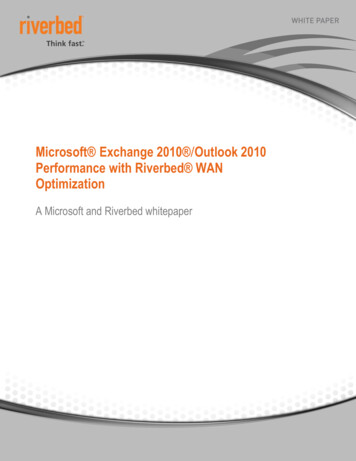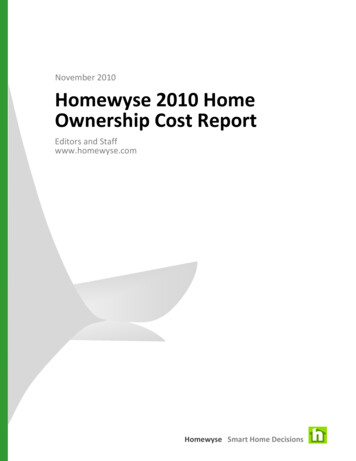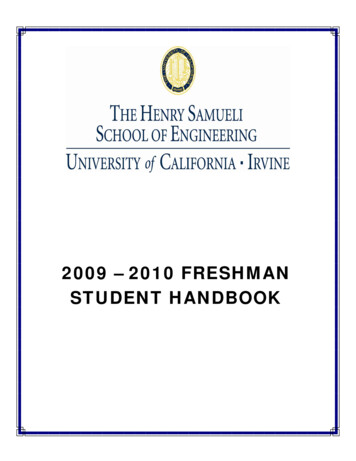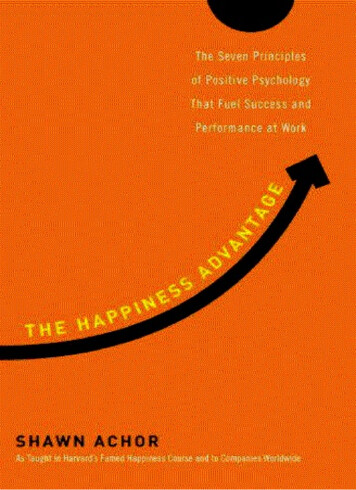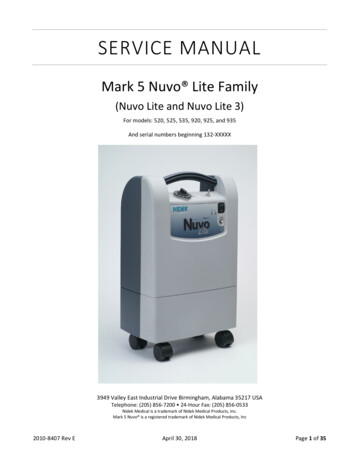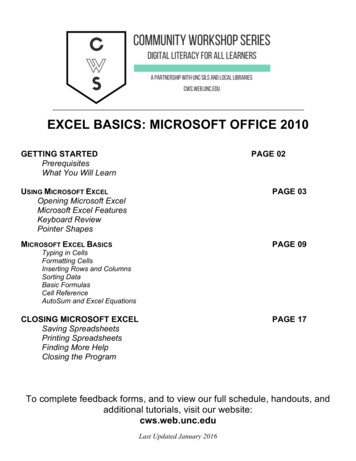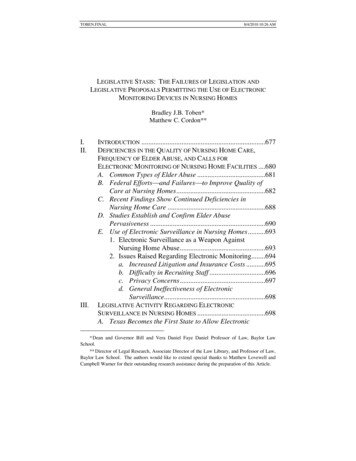
Transcription
TOBEN.FINAL8/4/2010 10:26 AMLEGISLATIVE STASIS: THE FAILURES OF LEGISLATION ANDLEGISLATIVE PROPOSALS PERMITTING THE USE OF ELECTRONICMONITORING DEVICES IN NURSING HOMESBradley J.B. Toben*Matthew C. Cordon**I.II.III.INTRODUCTION .677DEFICIENCIES IN THE QUALITY OF NURSING HOME CARE,FREQUENCY OF ELDER ABUSE, AND CALLS FORELECTRONIC MONITORING OF NURSING HOME FACILITIES .680A. Common Types of Elder Abuse .681B. Federal Efforts and Failures to Improve Quality ofCare at Nursing Homes .682C. Recent Findings Show Continued Deficiencies inNursing Home Care .688D. Studies Establish and Confirm Elder AbusePervasiveness .690E. Use of Electronic Surveillance in Nursing Homes .6931. Electronic Surveillance as a Weapon AgainstNursing Home Abuse .6932. Issues Raised Regarding Electronic Monitoring.694a. Increased Litigation and Insurance Costs .695b. Difficulty in Recruiting Staff .696c. Privacy Concerns .697d. General Ineffectiveness of ElectronicSurveillance.698LEGISLATIVE ACTIVITY REGARDING ELECTRONICSURVEILLANCE IN NURSING HOMES .698A. Texas Becomes the First State to Allow Electronic* Dean and Governor Bill and Vera Daniel Faye Daniel Professor of Law, Baylor LawSchool.** Director of Legal Research, Associate Director of the Law Library, and Professor of Law,Baylor Law School. The authors would like to extend special thanks to Matthew Lovewell andCampbell Warner for their outstanding research assistance during the preparation of this Article.
TOBEN.FINAL676IV.8/4/2010 10:26 AMBAYLOR LAW REVIEW[Vol. 59:3Monitoring.6991. Poor Conditions and Treatment in Texas NursingHomes and Previous Legislative Efforts.6992. Texas Legislature Passes Legislation AllowingCameras.7023. Provisions of the Texas Legislation andSubsequent Regulations .706B. Florida Legislation Fails .709C. Council of State Governments Recommends ElectronicMonitoring Statute.712D. Maryland Agency Issues Guidelines for ElectronicMonitoring.713E. New Mexico Passes Statute in 2004 .714F. Introduction of Bills in Other States .7171. Alabama .7172. Arkansas .7173. Louisiana .7184. Massachusetts .7195. Michigan .7196. Mississippi .7207. New Jersey .7208. North Carolina .7219. Ohio.72110. Pennsylvania .72111. South Carolina .72212. Tennessee .72213. Virginia .72214. West Virginia .723CONCERNS REGARDING ELECTRONIC MONITORINGSTATUTES AND PROPOSALS AND THE LACK OF LEGISLATIVEACTION .723A. Lack of Reliable Information About the Effectivenessof Electronic Monitoring .723B. Mixed Messages Regarding Potential Litigation andthe Effect on Insurance Costs .726C. Nursing Facility Quality Assurance Team Report .728D. Language of the New Mexico Legislation .729
TOBEN.FINAL2007]8/4/2010 10:26 AMELECTRONIC MONITORING IN NURSING HOMES6771. Patient or Surrogate.7302. Accommodation Without Undue Burden on theFacility .7303. Criminal Prosecution for Tampering with a Device .731RECOMMENDATIONS .732A. More Information is Needed About ElectronicMonitoring in Texas and New Mexico Nursing Homes .732B. The Federal Government Should at Least Take StepsAdopted in Maryland and Louisiana.732C. Federal and State Government Agencies Should ClearUp Questions Regarding the Viability of DUCTIONOn July 30, 2003, Willie Mae Ryan, an eighty-one-year-old nursinghome resident in Fordyce, Arkansas, suffered a savage beating in her room.1Attackers, allegedly two nursing home employees, used brass knuckles tocrush bones in Ryan’s face.2 Ryan died in at a nearby hospital about twoweeks later.3 Although brutal attacks such as this may not be common inArkansas nursing homes, nearly sixty nursing homes in Arkansas have beencited by inspectors for harming residents or placing residents in immediatejeopardy of harm.4 In response to Ryan’s death and concerns regarding theNurses Aide Says She Held Woman Down During Beating, AP ALERT ARK., Aug. 4, 2004,available at WL 8/4/04 APALERTAR 04:54:52.2Id. An eighteen-year-old nurse’s aide, Shermika Rainey, pleaded guilty to conspiracy tocommit murder and agreed to testify against a second defendant, Gayla Ann Wilson, a forty-fouryear-old employee of the facility. Id. Rainey claimed that Wilson had recruited the younger girlto hold Ryan down while Wilson beat her, allegedly for being disrespectful to Wilson. Arkansas:Aides Charged in Beating, N.Y. TIMES, Aug. 19, 2003, at A16, available at 2003 WLNR5635518. In two trials, juries failed to reach a verdict against Wilson, and prosecutors in June2005 decided not to pursue a new trial. Prosecutor Decides Against Third Trial in Death ofNursing-Home Resident, AP ALERT ARK., June 2, 2005, available at WL 6/2/05 APALERTAR10:03:21.3See Nurses Aide Says She Held Woman Down During Beating, supra note 1.4See Member of the Family L.L.C., National Nursing Home Watch List: Arkansas, June 25,2005, http://www.memberofthefamily.net/ar.htm; see also Rainer Sabin, “Granny Cam”Initiative Draws Support, AP ONLINE REGIONAL—U.S., Feb. 22, 2005, available at WL 2/22/05APONLINEUS 13:03:20.1
TOBEN.FINAL6788/4/2010 10:26 AMBAYLOR LAW REVIEW[Vol. 59:3quality of care offered in Arkansas nursing homes, state representativeStephen Bright in 2005 introduced legislation named the ―Willie Mae RyanNursing Home Patient Protection Act,‖ which would allow nursing homeresidents to place cameras in their rooms and would require nursing homefacilities to allow residents to install these cameras.5 According tosupporters, a monitoring device would allow families to watch howresidents are treated, which could deter acts of abuse or negligence bynursing home staff members.6 Bright’s bill garnered support from severalgroups, including the American Association of Retired Persons,7 theArkansas Advocates for Nursing Home Residents,8 and Ryan’s daughter.9Even though the legislation was only permissive in nature, allowingresidents and their families to install these devices if they so desired, thenursing home industry in Arkansas opposed the legislation.10 Despitenegotiations between supporters of the bill and the nursing home industry,11which allowed the bill to pass in the Arkansas House of Representatives,the bill later failed to pass in the Arkansas Senate.12 The result is that evenif a nursing home resident wishes to install a camera in her room a rightthat she would undoubtedly have in her own home a nursing home facilitycould remove the camera at its discretion.The proposal of the electronic monitoring legislation followed bylegislative inaction is hardly unique to Arkansas. In an effort to combatincidents of abuse and neglect in nursing homes, several state legislatures inthe early 2000s began to consider proposals that would allow nursing home5H.R. 1392, 85th Gen. Assem., Reg. Sess. (Ark. 2005), WL 2005 AR H.B. 1392 (NS).Bright also introduced legislation in 2001 and 2003, but both bills died in their respectivecommittees. See discussion infra Part III.F.2.6See Sabin, supra note 4.7Id.8See Nancy Allison, From the President’s Desk, PROTECTING NURSING HOME RESIDENTS(Ark. Advocates for Nursing Home Residents, Little Rock, Ark.), March 2005, at 2, available athttp://www.aanhr.org/March2005.pdf.9Sabin, supra note 4.10See James Jefferson, Frustrated Sponsor Pulls “Granny Cam” Bill, AP ALERT ARK.,Feb. 23, 2005, available at WL 2/23/05 APALERTAR 10:16:20.11Melissa Nelson, Panel OKs Bill for Cameras in Ark. Nursing Homes, AP ALERT ARK.,Mar. 10, 2005, available at 3/10/05 APALERTAR 22:11:39.12Bill To Put Video Cameras in Nursing Homes Fails, AP ALERT POLITICAL, Apr. 12,2005, available at WL 4/12/05 APALERTPOLITICS 00:15:53.
TOBEN.FINAL2007]8/4/2010 10:26 AMELECTRONIC MONITORING IN NURSING HOMES679residents to install electronic monitoring devices in their rooms. 13 By 2001,several advocacy groups for the elderly and nursing home residents inparticular generally supported legislation that would require nursing homefacilities to allow residents to install electronic monitoring devices, alsodubbed ―granny cams,‖ in their rooms.14 Texas became the first state toenact such permissive legislation in 2001,15 followed by New Mexico in2004.16 Based on the apparently significant level of support for thislegislation, the Council of State Governments in 2002 recommended thatstates pass legislation based on the Texas model.17In spite of the attention paid to this subject, most proposals have died inlegislative committees.18Moreover, permissive use of electronicmonitoring devices in Texas and New Mexico has produced little or noevidence that either supports the use of these devices19 or sustains claimsthat electronic monitoring will cause more problems in nursing homefacilities than it will curb incidents of abuse or neglect.20 Although somestates continued to consider this type of legislation in 2005,21 the prospectof the use of electronic monitoring as a tool to protect nursing homeresidents appears to be waning.This Article focuses on the rise in advocacy in the use of electronicmonitoring in nursing homes and the subsequent failure of legislation andlegislative proposals to incorporate electronic monitoring as an effectivetool against abuse and neglect in nursing homes. Part II examines thehistory of deficiencies in the quality of nursing home care, the increase in13See discussion infra Parts II.E, III. Three previous articles in legal scholarship haveaddressed several issues related to electronic monitoring. See Elizabeth Adelman, VideoSurveillance in Nursing Homes, 12 ALB. L.J. & SCI. TECH. 821 (2002); Selket Nicole Cottle,Note, “Big Brother” and Grandma: An Argument for Video Surveillance in Nursing Homes, 12ELDER L.J. 119 (2004); Tracey Kohl, Comment, Watching Out for Grandma: Video Cameras inNursing Homes May Help to Eliminate Abuse, 30 FORDHAM URB. L.J. 2083 (2003). Numerousarticles about this subject have also appeared in the general media.14See discussion infra Part II.E.15See discussion infra Part III.A.16See discussion infra Part III.E.17See discussion infra Part III.C.18See discussion infra Part III.B,F.19See discussion infra Part II.E.1.20See discussion infra Part II.E.2.21In addition to Arkansas, the states of Michigan, Mississippi, Pennsylvania, and WestVirginia considered bills in 2005 that would permit residents to install electronic monitoringdevices. See discussion infra Part III.F.
TOBEN.FINAL6808/4/2010 10:26 AMBAYLOR LAW REVIEW[Vol. 59:3frequency of reported incidents of abuse in nursing homes, and theintroduction of electronic monitoring as a possible alternative that couldimprove the quality of life for nursing home residents. Part III summarizesefforts among state legislatures to enact statutes relating to electronicmonitoring. Part IV details some concerns regarding electronic monitoringand electronic monitoring legislation, and Part V providesrecommendations for further studies and legislative action.II. DEFICIENCIES IN THE QUALITY OF NURSING HOME CARE,FREQUENCY OF ELDER ABUSE, AND CALLS FOR ELECTRONICMONITORING OF NURSING HOME FACILITIESReports containing statistics regarding abuse of the elderly and abusetaking place in nursing homes have been staggering. One report, preparedby the minority staff of the Special Investigations Division of the HouseCommittee on Government Reform, found that nearly one-third of thenursing homes in the U.S. had been cited for an abuse violation during atwo-year period from 1999 through 2001.22 These numbers were consistentwith statistics reported in earlier studies indicating that many thousands ofelderly persons annually in the U.S. were subject to some form of abuse in adomestic setting.23 The statistics also correlate with findings that chronicquality of care problems have existed in many nursing homes on a nationalbasis, notwithstanding efforts by Congress and state governments to addressthese concerns.24 The inability of state and federal governments to addressthese problems effectively has directly led to calls by elderly rightsadvocates for the installation of electronic surveillance devices in nursinghomes.This section explores background statistics and other informationregarding abuse of the elderly and problems associated with the nursing22MINORITY STAFF OF SPEC. INVESTIGATIONS DIV. OF H. COMM. ON GOV’T REFORM, 107THCONG., ABUSE OF RESIDENTS IS A MAJOR PROBLEM IN U.S. NURSING HOMES i (Comm. Print2001) [hereinafter ABUSE OF RESIDENTS].23See NAT’L CTR. ON ELDER ABUSE AT THE AM. PUB. HUMAN SERVS. ASS’N, THENATIONAL ELDER ABUSE INCIDENCE STUDY 1 (1998) [hereinafter ABUSE INCIDENCE STUDY](reporting that 450,000 elderly persons in the United States were abused or neglected in 1996).24See OFFICE OF INSPECTOR GEN., DEP’T OF HEALTH & HUMAN SERVS., NURSING HOMEDEFICIENCY TRENDS AND SURVEY AND CERTIFICATION PROCESS CONSISTENCY iii (2003)[hereinafter DEFICIENCY TRENDS 2003]; OFFICE OF INSPECTOR GEN., DEP’T OF HEALTH &HUMAN SERVS., NURSING HOME SURVEY AND CERTIFICATION: DEFICIENCY TRENDS 2 (1999)[hereinafter DEFICIENCY TRENDS 1999].
TOBEN.FINAL2007]8/4/2010 10:26 AMELECTRONIC MONITORING IN NURSING HOMES681home care in the U.S. This section also summarizes calls for theinstallation of electronic monitoring devices, as well as issues that critics ofelectronic surveillance of nursing homes have raised.A. Common Types of Elder AbuseElder abuse is as much a domestic violence problem as it is a nursinghome problem. The National Center on Elder Abuse (NCEA) in 1998prepared a report entitled The National Elder Abuse Incidence Study for theAdministration for Children and Families and the Administration on Agingin the U.S. Department of Health and Human Services.25 After reviewingapplicable state definitions of elder abuse and after consulting with severalexperts on the subject, the NCEA prepared a list of definitions applicable tothe elder abuse problems.26 These definitions, as presented in the report’sexecutive summary, are as follows:Physical abuse was defined as the use of physical forcethat may result in bodily injury, physical pain, orimpairment. Physical punishment of any kind wereexamples of physical abuse.Sexual abuse was defined as non-consensual sexualcontact of any kind with an elderly person.Emotional or psychological abuse was defined as theinfliction of anguish, pain, or distress.Financial or material exploitation was defined as theillegal or improper use of an elder’s funds, property, orassets.Abandonment was defined as the desertion of an elderlyperson by an individual who had physical custody orotherwise had assumed responsibility for providing care foran elder or by a person with physical custody of an elder.Neglect was defined as the refusal or failure to fulfill anypart of a person’s obligations or duties to an elder.Self-neglect was characterized as the behaviors of anelderly person that threaten his/her own health or safety.2526For statistics from this study, see discussion infra Part II.D.See ABUSE INCIDENCE STUDY, supra note 23, at 11–12.
TOBEN.FINAL6828/4/2010 10:26 AMBAYLOR LAW REVIEW[Vol. 59:3The definition of self-neglect excludes a situation in whicha mentally competent older person (who understands theconsequences of his/her decisions) makes a conscious andvoluntary decision to engage in acts that threaten his/herhealth or safety.27For purposes of this Article, these definitions28—which this Articleassumes to be accurate—are sufficient to demonstrate the types of problemsrelated to elder abuse in the U.S.B. Federal Efforts and Failures to Improve Quality of Care atNursing HomesEfforts by Congress and federal agencies to improve the quality of careat nursing homes historically have been futile. The involvement of thefederal government in the nursing home industry originated with thepassage of the Social Security Act of 1935,29 although state governmentalunits were still mostly responsible for regulatory oversight of nursinghomes.30 Studies during the mid-1950s indicated that few nursing homes atthe time offered skilled nursing services.31 In 1955, the Council of StateGovernments released a study showing that a majority of nursing homesfunctioned under low standards of service and with relatively untrainedpersonnel.32 Similarly, a 1957 report of a study conducted by theCommission on Chronic Illness found numerous problems with the quality27Id.The lack of standardized definitions has posed problems for agencies and researchers incollecting and analyzing data related to elder abuse. See OFFICE OF EVALUATION & INSPECTIONS,DEP’T OF HEALTH & HUMAN SERVS., ABUSE COMPLAINTS OF NURSING HOME PATIENTS 3(1999) [hereinafter ABUSE COMPLAINTS] (noting that definitions of abuse of elderly persons ―varybetween [s]tates regarding what constitutes abuse, neglect, or exploitation of an elderlyindividual‖).29Social Security Act, ch. 531, 49 Stat. 620 (1935) (codified as amended in scattered sectionsof 42 U.S.C.). For more detailed information regarding the history of federal involvement withnursing homes, see COMM. ON NURSING HOME REGULATION, INST. OF MED., IMPROVING THEQUALITY OF CARE IN NURSING HOMES 238–53 (1986) [hereinafter IMPROVING THE QUALITY OFCARE].30See David A. Bohm, Striving for Quality Care in America’s Nursing Homes: Tracing theHistory of Nursing Homes and Noting the Effect of Recent Federal Government Initiatives ToEnsure Quality Care in the Nursing Home Setting, 4 DEPAUL J. HEALTH CARE L. 317, 329–31(2001).31See IMPROVING THE QUALITY OF CARE, supra note 29, at 239.32Id. at 239–40.28
TOBEN.FINAL2007]8/4/2010 10:26 AMELECTRONIC MONITORING IN NURSING HOMES683of care given by nursing homes.33 The Committee on Labor and PublicWelfare of the U.S. Senate i
that electronic monitoring will cause more problems in nursing home facilities than it will curb incidents of abuse or neglect.20 Although some states continued to consider this type of legislation in 2005,21 the prospect of the use of electronic monitoring as a tool to protect nursing home residents appears to

